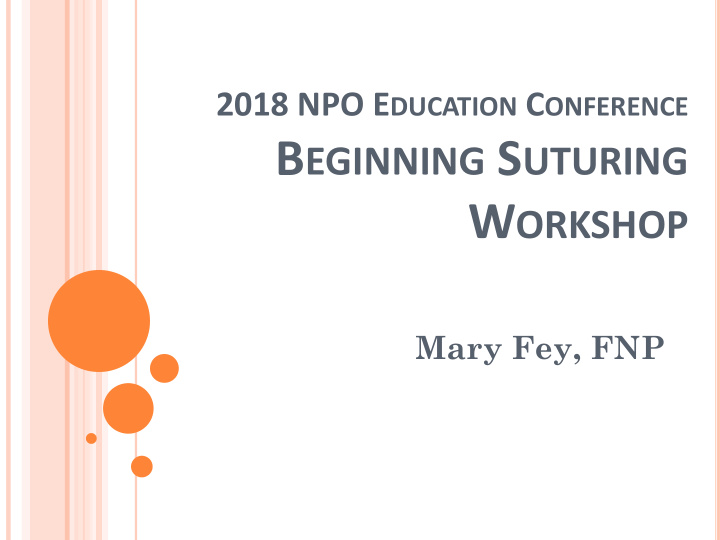



2018 NPO E DUCATION C ONFERENCE B EGINNING S UTURING W ORKSHOP Mary Fey, FNP
G OALS OF W OUND M ANAGEMENT • Avoid infection • Hemostasis • Esthetically Pleasing Scar
T ISSUE L AYERS Epidermis Dermis -indistinguishable from each other visibly Subcutaneous Layer -Adipose, nerve fibers, blood vessels, hair follicles Deep Fascia -Muscle
M ECHANISM OF W OUND H EALING Coagulation begins immediately -vasospasm, platelet aggregation, fibrous clot formation Epitheliazation occurs in epidermis -complete bridging of wound occurs in 48 hours New blood vessel growth peaks 4 days after injury Collagen formation begins 48 hours, peaks first week, continues 12 months Wound contraction occurs 3-4 days after injury -full wound thickness moves toward center of wound
W OUND A SSESSMENT • Mechanism of Injury • Age of Injury • Possible contamination or foreign body • Extent of the wound • Neurovascular Compromise or tendon injury • Need for Tetanus prophylaxis • Risk factors that might affect healing, i.e. Diabetes, immunocompromised
C ONTRAINDICATIONS OF C LOSURE • Animal Bites • Deep puncture Wounds • Actively bleeding (arterial) • Stained wounds (Grease)
T IMING OF C LOSURE Preferably within 6 hours Up to 18 hours if no concerns of infection (High Risk) Diabetic Contaminated Wound May need to debride edges if greater than 6 hours
W OUND P REPARATION Clean and/or Irrigate • Normal Saline • Surfactant Cleaners (ShurClens) Debridement
A NESTHESIA Lidocaine 1% Use when need large amount Lidocaine2% Most common Lidocaine 2% plus Epinephrine Use UNLESS fingers, toes, penis, or nose (and earlobes) Marcaine 0.5% (Lasts longer) Sensorcaine 0.5% Sodium Bicarbonate Lessens ‘sting’ of Lidocaine Do not use with Marcaine or Sensorcaine (precipitates)
E QUIPMENT • Needle Holder • Tissue Forcep • Iris Scissors • Face Shield • 3 cc Syringe with 25-30 g. needle
C OMMON S UTURE M ATERIALS Dermal Suture Material : • Needles ( 3/8 circle most common) • Ethilon 6-0 Face 5-0 Everywhere else • Prolene 6-0 Face
I NTERRUPTED S UTURE Most Common and Recommended • Evert edges of wound • Penetrate skin surface at 90 degree angle • Loop same distance at skin and base of wound • Start in center • Equal amount of sutures on both sides
C ORRECT VS . I NCORRECT
F IGURE OF 8 S UTURE Useful for closing punch biopsy and very small laceration
F IGURE OF 8 S UTURE A C A C D B D B
S UTURE R EMOVAL • Face/neck 3-5 days • Scalp 7-10 days • Trunk 7-10 days • Joints 10-14 days • Back/Foot 10-14 days
S TAPLES Great for Scalp Wounds Good for Tension Wounds (Knee laceration) Start at one end and advance to other end May be able to apply with just local anesthetic if only 1-2 staples – Good for someone who is having high anxiety
S TAPLE T ECHNIQUE
D ERMABOND • Useful for small clean wounds
Works Cited Patrick, J. (2003, Sep 14). Mt. auburn hospital emergency department: wound care. Retrieved Sep 8, 2012, from jpatric.net: http://www.jpatrick.net/MAHFiles/orient/woundcare_manual.html
C ORNER S TITCH “B OAT IN THE D OCK ”
C ORNER S TITCH H ALF - BURIED HORIZONTAL MATTRESS • Start suture in epidermis across from flap • Insert needle into dermis only and come out in dermis • Assure you have a ‘good bite’ • Exit through dermis very near insertion point • Apply sufficient tension to pull flap into corner • Tie knot across from corner of flap
B IBLIOGRAPHY • Boriskin, Mitchell: “Primary Care Management of Wounds”, Nurse Practitioner 1994, pp. 38-58. • Christoph, R.A. et al.: “Pain Reduction in Local Anesthesia Administration Through pH Buffering”, Annals of Emergency Medicine, 1988, 17:2, pp. 117/27-120/30. • Patrick, J. (2003, Sep 14). Mt. auburn hospital emergency department: wound care. Retrieved Sep 8, 2012, from jpatric.net:http://www.jpatrick.net/MAHFiles/orient/wo undcare_manual.html • Trott, A: Wounds and Lacerations: Emergency Care and Closure, St. Louis, Mosby Year Book, Inc., 1991
Recommend
More recommend